
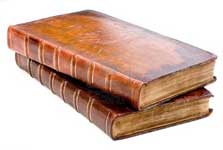
Pattern and shape records are important documents for any working pottery and are closely guarded, not least from a competitor. The information that pattern records hold, such as decorating techniques, colours and glazes used for each decoration enabled the pottery to maintain standards and be consistent.
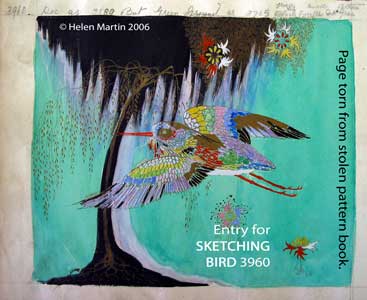
Page torn from stolen pattern book.
When patterns and shapes become obsolete this importance lessens and sometimes such records are discarded or lost. This was the case with Carlton Ware's early shape and pattern records for ware made between 1890 and c.1911, when Blushware reigned. Fortunately, pattern records had survived from about 1912, when Horace Wain joined the pottery.
Many shape records also escaped loss. Such documents enable a much clearer history of a pottery to be revealed.
The article below was first published on our Latest News page in November 2010. It chronicles the sad tale of Carlton Ware's pattern records after they were sold along with the trade mark (the Script backstamp) in 1989. However the cloud of the story has a silver, or should we say gold printed, lining!
Harvey Pettit recounts an extraordinary coincidence...
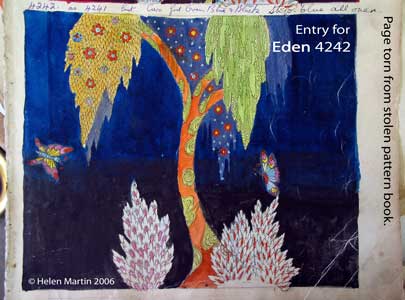
Page torn from stolen pattern book.
Because of their historical importance, we persuaded Anthony Wood, who then owned the pottery, to store them in an office safe. Whilst the books were not in use, there they were kept until receivership in 1989, when they and the Carlton Ware trade mark (the Script backstamp) were sold to John McCluskey, a manufacturer of ceramic door furniture in nearby Stone.
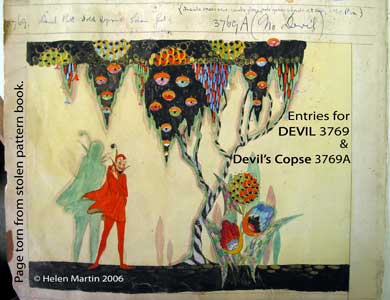
Page torn from stolen pattern book.
In 2006, fourteen years later, an extraordinary coincidence occurred. Helen Martin, who did freelance work for the auctioneers Mellors & Kirk, received a phone call from the saleroom to be told that some pattern records, thought to be from Carlton Ware, had been brought in for valuation.
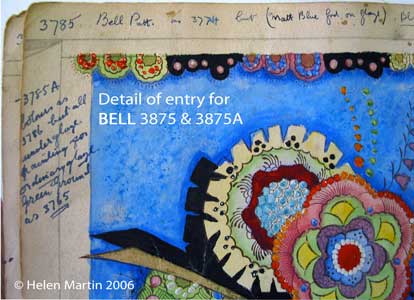
Page torn from stolen pattern book.
As a leading expert on Carlton Ware, Helen was asked by Mellors & Kirk to advise. Having known of the original theft, with camera at the ready, she drove over to the rooms to investigate, hopeful that the stolen book had surfaced. However, there was no book but instead twenty five sheets of designs. Helen dutifully photographed the records and emailed them through to me.
Were they from the missing book or not? How would we be able to tell? Oh dear! If they were, then they had been torn out of the book!
One of the first things that Peter Cochrane and I did on our frequent visits to Copeland Street throughout the 1980s was to photograph the pattern and shape books. These were pre-digital days, so we had to use film, a lengthy but necessary task and one that, as we shall see, would eventually pay dividends.
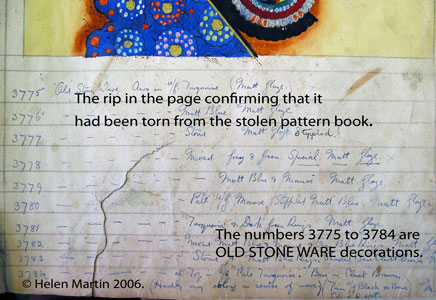
Because of our photographs, I was able to compare our photographs with the images that Helen had taken.
One particular picture would easily identify them one way or the other. It showed a tear and if this matched then without any doubt the pages had been removed from the stolen book.
The pictures matched exactly.
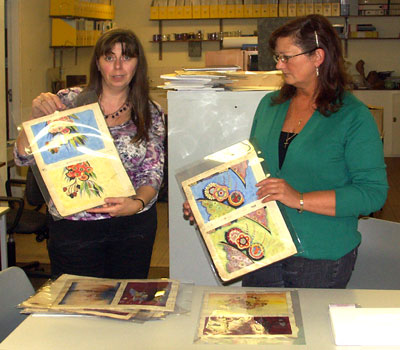
I called John McCluskey straight away only to find that he was in Australia. Fortunately, we managed to track him down but his stay in Oz was to be lengthy.
John appointed Helen and me to act as his representatives and so we contacted the police. The pattern records were duly confiscated to be returned to the rightful owner on his return to the UK.
Team work - there is nothing to beat it!
Mr. Mccluskey's Generosity.
With little persuasion, John agreed to donate the recovered pages to the Potteries Museum & Art Gallery along with two Carlton Ware shape books and two Birkes Rawlins pattern books that also came from Carlton Ware's Copland Street works when liquidated in 1989. The Museum is where they are kept today. In 2013 Carlton Ware World organised a trip to view them all.
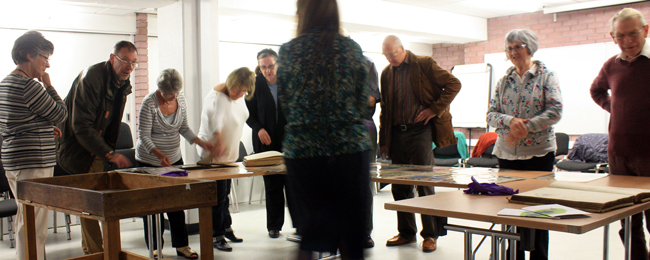
How fortuitous and indeed incredible that the pattern book pages were taken to the saleroom for which Helen worked, making it possible to identify them as stolen and returned to their rightful owner. Violet Elmer and Rene Pemberton, whose work they illustrate, must have been guarding them! Had the pages been taken to another saleroom, we may not have discovered them and so they could have disappeared again.
The sad part of the story is that the recovered pages represent only ten percent of the book. Inevitably, it is the most photogenic records that were removed. Will the remaining records surface? We wait for the phone to ring!
© Harvey Pettit 2010 & 2013.
If you know of the whereabouts of the remaining records you can contact Harvey here in complete confidence and with no questions asked and we will see that they are lodged with the Museum.
We would like to thank Helen Martin for her pictures of the stolen pages, as well as The Cochrane & Pettit Archive of Carlton Ware. Also Miranda Goodby for permission to use the photograph taken at the Potteries Museum & Art Gallery. Last but not least, thanks to Anthony Wood for allowing us access to the original books all those years ago.